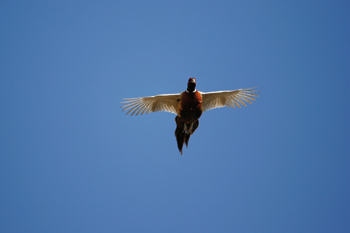The appeal of wild game and release of large numbers of reared birds have dented the reputation of the pheasant, says David Tomlinson, explaining why we shouldn’t take the gamebird for granted
The popularity of wild game and large numbers released has tarnished the reputation of the pheasant, argues David Tomlinson. But our best gamebird still deserves the utmost respect – and musn’t be overlooked this season.
Knowing how to shoot pheasants properly is a lesson that every sportsperson must learn. Do your homework and read how to shoot pheasants like George Digweed before you head into the field this season.
THE BEST GAMEBIRD
It’s hard to think of a better gamebird than the pheasant. Handsome, tough, adaptable, easy to rear, strong flying and delicious, the pheasant has it all. Yet in some circles it has become fashionable to dismiss Phasianus colchicus as unworthy of a true sportsman’s attention, especially compared with wild game such as grouse, grey partridges and even woodpigeon.
However, there’s more than a whiff of inverted snobbery in such an attitude – or, perhaps, it is a case of familiarity breeding contempt. It may even be because pheasant shooting has become too popular for its own good. You can, if you so wish, buy a 1,000-pheasant day if your pocket is deep enough. Shooting pheasants in such numbers diminishes respect for the quarry and goes a long way to explaining why the reputation of this splendid sporting bird has become tarnished. Too often pheasants are released in ridiculous densities into the countryside then shot before they have had much time to acclimatise to the wild. Such shooting has become a numbers game, with the principle of presenting the most challenging birds possible either forgotten or ignored. To make matters worse, we are approaching the stage when it may become normal to pay game dealers to take away shot birds, if the market is saturated.
It’s high time we took a fresh look at the pheasant and started to appreciate it for its qualities once again. Let’s start by losing the comparison with wild game.
There is a great demand for shooting in this country and this could never be met by wild game. Pheasants will thrive in habitats and at altitudes where red-legged partridges struggle. The pheasant may once have been an exotic “foreigner” but he has been with us since Roman times – long enough to become an integral member of our flora and fauna, along with other “foreigners” such as the rabbit, hare and fallow deer.
Pheasant shooting is an essential part of the rural economy, with thousands of full-time jobs depending on it. It also gives a great deal of pleasure (and part-time employment) to beaters and gundog enthusiasts. Estimates suggest the shooting industry contributes up to £2 billion to the UK economy. Without the reared pheasant it would be a fraction of this.
We should never forget that pheasant shooting helped shape our countryside and continues to do so today. Many lowland woods, spinneys and coverts owe their existence to the pheasant, for they were planted, or left unfelled, because of shooting. Today, thousands of acres of gamecover are grown every season, and field margins and headlands are left unploughed, just for the pheasant. Of course, it’s not just pheasants that benefit from such measures; so, too, does a rich variety of wildlife. Well-managed shooting estates invariably support a greater variety and abundance of wild birds than neighbouring land that isn’t shot over.
It’s not hard to find specific examples to back this up. In the Norfolk/Suffolk Brecks, there’s a thriving population of stone curlews, one of Britain’s rarest breeding birds. These birds enjoy their best nesting success on shooting estates where foxes and other ground predators are controlled. Without the shooting interest there would be few, if any, stone curlews, which are here at the very northern limit of their breeding range.
There’s one misconception that needs to be exposed: pheasants are not as easy to shoot as their detractors may claim. True, a lumbering, inexperienced, early-season bird might not test the guns, especially on a low-ground shoot where little thought has gone into presenting birds well. In contrast, a high-flying, late-season cock drifting on the wind will challenge even the very best.
In 1905, AET Watson, then editor of The Badminton Magazine, quizzed 15 of the greatest sportsmen of the Edwardian era as to which was the most difficult shot. These were men with considerable experience of gameshooting, the list including such redoubtable figures as Prince Victor Duleep Singh, the Marquess of Granby, the Marquess of Ripon and Lord Walsingham. Eleven of the 15 opted for the pheasant in its different guises. Duleep Singh thought that a high dropping pheasant with its wings almost motionless was as tricky as it gets, while several agreed that the easiest bird to miss was a high pheasant curling on the wind.
Ask a similar question today and grouse will get many a mention but is this because grouse have a considerably shorter season than pheasants, so few people get the same amount of practice on them? It might also be a case of that inverted snobbery creeping in again. When, five years ago, The Field posed the-most-difficult-shot question to what it described as “a similarly impressive panel of stellar shots”, several were honest enough to name the pheasant, including William van Cutsem, who considered “the bird that takes the greatest technique is a really high pheasant in a strong crosswind. You have to get your feet in the right position and judge so many different things.”
So this season, don’t take the pheasant for granted but look at him for what he is: the most sporting of birds, a handsome devil and one that deserves the utmost respect. However, what pheasant shooting needs most is a move from quantity to quality, as only this will restore the pheasant’s tarnished reputation.





